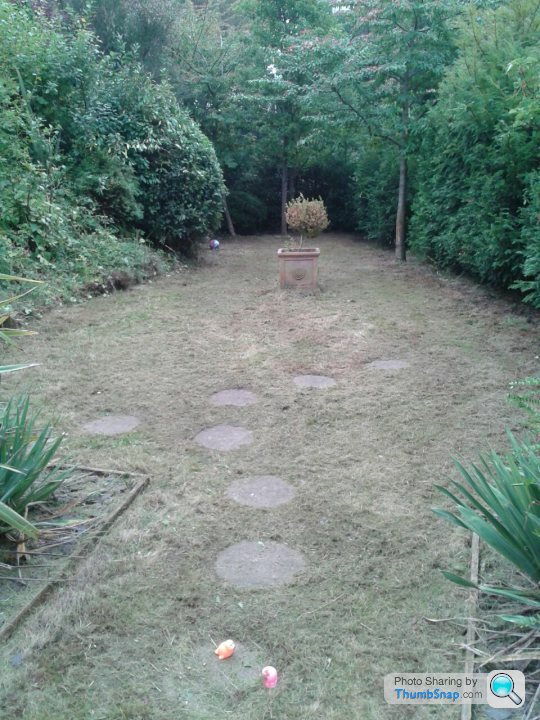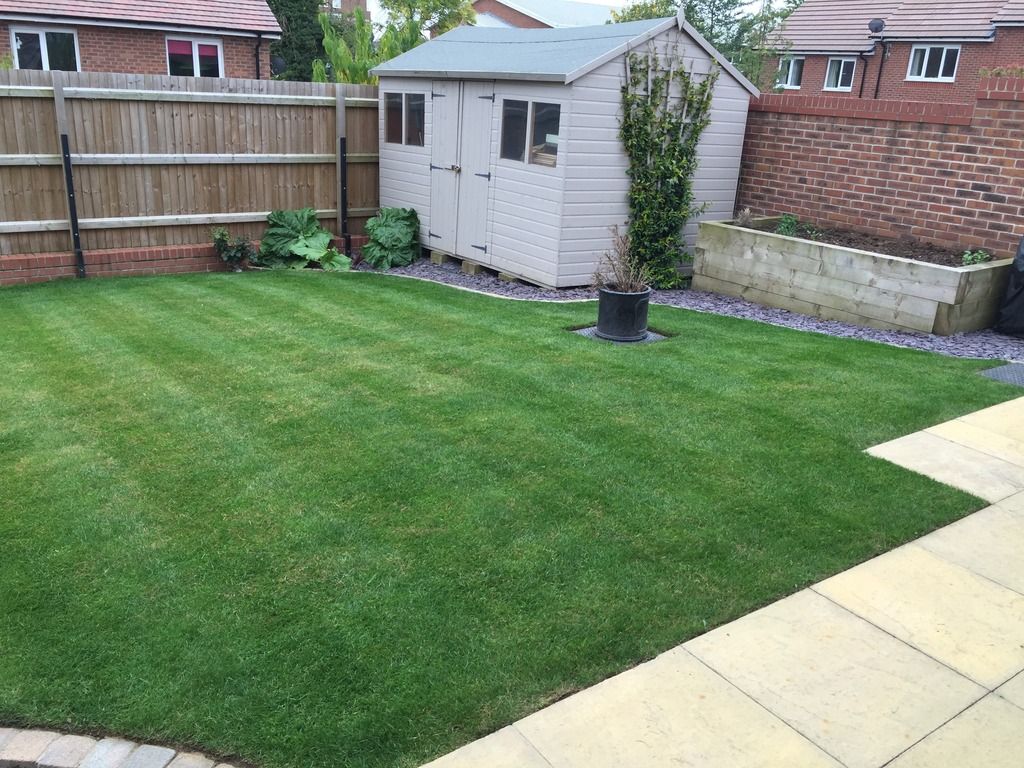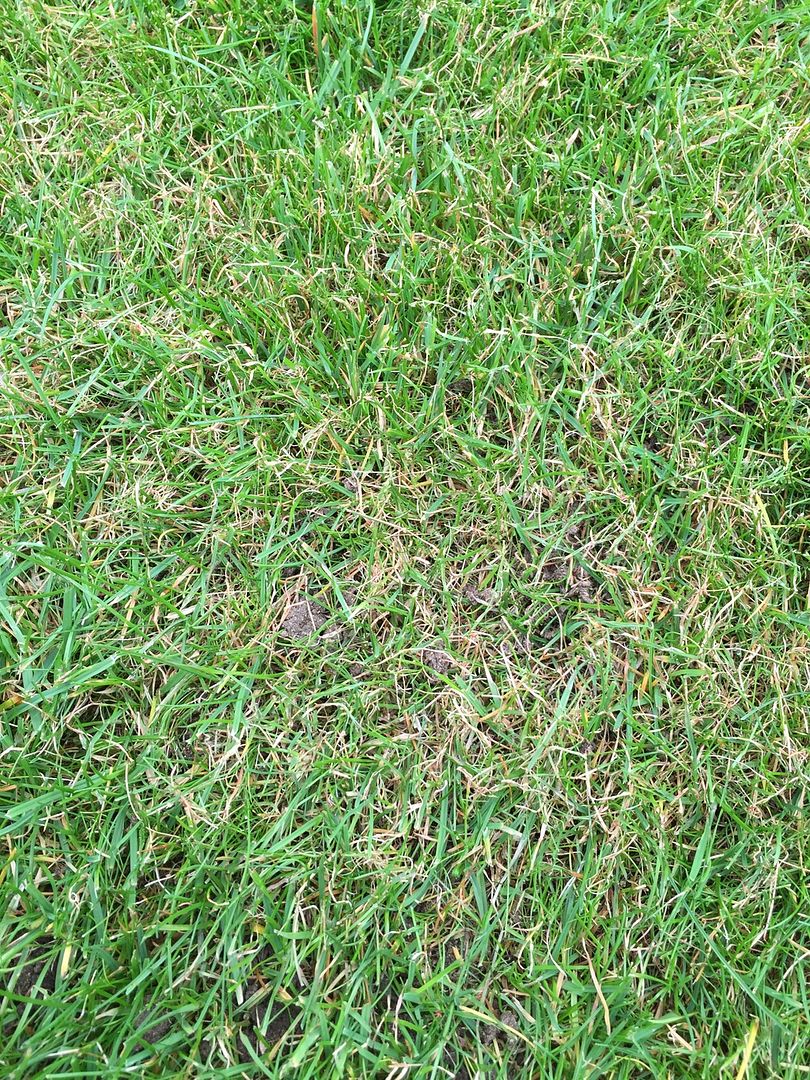2015 Lawn thread
Discussion
Having levelled the lawn a few weeks ago and overseeded I now have a few patches where I guess the dips where lower than others and so the old grass hasn't grown through and so it appears as a patch of new growth. Have I messed up and will now be left with a few patches of finer grass or will the old turf eventually break through the soil. I can't imagine the soil would be more than a couple of inches deep.
tim0409 said:
I've run into some difficulties with my lawn and would welcome some advice...
Quick recap - I recently scarified (huge amount of thatch removed) and re-seeded last week; the seed doesn't look like it's going to take and on closer inspection there is still a layer of muddy thatch which is really matted (see pic). When I was scarifing I used a very low setting so I'm not quite sure what has happened.
Parts of mine are v similar and the grass has grown very poorly. Think you need to try and work it deeper so the seed gets into the soil. The areas where I did a proper job are 10 times better than the bank where my scarifier didnt go as deep. Quick recap - I recently scarified (huge amount of thatch removed) and re-seeded last week; the seed doesn't look like it's going to take and on closer inspection there is still a layer of muddy thatch which is really matted (see pic). When I was scarifing I used a very low setting so I'm not quite sure what has happened.
Dr Mike Oxgreen said:
Nervousness is perfectly normal after you've scarified, and let me tell you it's even worse if you've killed off what everyone else thought was a perfectly good lawn and now you're desperately hoping the seed is going to save your blushes. I'm rapidly forming the opinion that lawncare is not a good hobby if longevity is something you aspire to.
 The pressure's starting to tell now then?
The pressure's starting to tell now then? 
It's odd though - likewise I stress over the new grasses establishing on the existing lawn, worrying that the choice of grass type was a mistake and watching daily for it to at least achieve what was there previously; yet I'm totally relaxed about the rate of development on the old path area.
It'll come good. It's got all winter to develop, and it takes time for the grasses to establish, tiller and send out their rhizomes etc. Spring is when it'll really be looking its best.
richierich37 said:
jagnet said:

I'd be so tempted to go all out on getting my turf to visually overpower his in that situation


 turf wars are so much fun. Visual tricks worth trying are: cutting your side higher than his, leaving a dark stripe against his grass when viewed from the road (or whichever view you want most impact) and going over that stripe two or three times whenever you cut to really make it distinct. Make sure that the edging along the pavement and drive is perfect and when fertilising try to get a nice clean dividing line between the two areas.
turf wars are so much fun. Visual tricks worth trying are: cutting your side higher than his, leaving a dark stripe against his grass when viewed from the road (or whichever view you want most impact) and going over that stripe two or three times whenever you cut to really make it distinct. Make sure that the edging along the pavement and drive is perfect and when fertilising try to get a nice clean dividing line between the two areas. If you overseed again in the spring, or whenever you do next overseed, consider using Germinal Amenity's A26 So Green. The Abernile ryegrass stays green even in winter and in times of water stress. It really is quite remarkable, and it'll be very obviously greener than his turf.
Also consider using a liquid seaweed with iron feed to help create a deeper green to the turf.
wseed said:
Having levelled the lawn a few weeks ago and overseeded I now have a few patches where I guess the dips where lower than others and so the old grass hasn't grown through and so it appears as a patch of new growth. Have I messed up and will now be left with a few patches of finer grass or will the old turf eventually break through the soil. I can't imagine the soil would be more than a couple of inches deep.
Probably not if there's more than a few millimeters and certainly not through two inches of soil if it is that deep, but there will be some blending of the edges which will soften the visual impact of the patches. Repeated overseeding will naturally increase the proportion of those finer grasses as well, further blending it all in.I wouldn't panic - those patches will look very obvious now but by spring they'll be far harder to spot.
When aerating, concentrate on those areas and make sure that the holes pass through the old top layer to prevent it forming a soil horizon.
jagnet said:
 turf wars are so much fun. Visual tricks worth trying are: cutting your side higher than his, leaving a dark stripe against his grass when viewed from the road (or whichever view you want most impact) and going over that stripe two or three times whenever you cut to really make it distinct. Make sure that the edging along the pavement and drive is perfect and when fertilising try to get a nice clean dividing line between the two areas.
turf wars are so much fun. Visual tricks worth trying are: cutting your side higher than his, leaving a dark stripe against his grass when viewed from the road (or whichever view you want most impact) and going over that stripe two or three times whenever you cut to really make it distinct. Make sure that the edging along the pavement and drive is perfect and when fertilising try to get a nice clean dividing line between the two areas. If you overseed again in the spring, or whenever you do next overseed, consider using Germinal Amenity's A26 So Green. The Abernile ryegrass stays green even in winter and in times of water stress. It really is quite remarkable, and it'll be very obviously greener than his turf.
Also consider using a liquid seaweed with iron feed to help create a deeper green to the turf.

Dr Mike Oxgreen said:
So, so childish.


 oh yes, I'll hold my hands up to that
oh yes, I'll hold my hands up to that 
Well my lawn isn't quite where I was hoping it'd be at this stage. The worm cast problem has been such a major issue, leaving the lawn looking as though it's had a nasty case of teenage acne in places. The casts have really messed up my careful levelling, and with the daily sweeping up it's also thinned out the delicate new grasses in places where they're a little weaker. The constant irrigating to get successive batches of seed to germinate is risking Pythium root rot now so that's going to have to stop. Any seed that hasn't yet germinated will have to stay like that.
That said, it's not too bad and obviously looks worse when viewed directly from above. Looking across the lawn it's pretty good overall. I think there's enough established new grass now to develop well over the rest of the autumn and into winter, but I reckon it's going to be safer to leave the cutting height up at ten millimeters; unfortunately that makes the darker colour of the older grasses more obvious. Whilst it would have been nice to get it more blended in before winter, that can be worked on in the spring with another overseeding before lowering the cutting height further.
I knew that sowing a velvet bentgrass lawn was going to be a major challenge and not without risks so I'm not too disappointed, it just would've been nice not to have had quite such a worm issue. Hopefully, continuing to box off the clippings and only irrigating early in the morning when absolutely necessary will help.
smokeey said:
Now I just need to sort the state of the grass, any suggestions?
It's likely a touch too late now to be doing any major renovations, being more northerly and the garden being so shaded. If the weather's kind then you might be ok, but you'd need to be on very good terms with whoever the patron saint of lawncare is.For now I'd give it a rake, use a garden fork to decompact and aerate, get some autumn feed down and cut on the high side (1.5 to 2 inches) to let it recover, spot treating weeds as they appear. You can then get a clearer picture of what sort of condition it's in, and what sort of grass mix there is prior to more extensive work where required in the spring.
You've done a great job to get that back under control!
Looking at the 'before' picture, it looks like there was a decent population of fine grass; it had just been left to go riot. If you're lucky and it recovers, you might end up with a decent lawn.
I agree with the others - too late to put seed down now, so just spike it and feed it, then overseed in mid-to-late Spring.
Looking at the 'before' picture, it looks like there was a decent population of fine grass; it had just been left to go riot. If you're lucky and it recovers, you might end up with a decent lawn.
I agree with the others - too late to put seed down now, so just spike it and feed it, then overseed in mid-to-late Spring.
Yoof said:
Another light scarify required?
I wouldn't, as your new grasses won't yet be established enough to cope with that. You could try gently raking with a plastic rake if you have one to remove any loose dead material, but I'd avoid a spring tine rake for now for the same reasons as avoiding another scarification.Now the question is, is the dead material left over from when you scarified or has some of it appeared since? Whilst the new growth is clearly coming through I am also seeing some fresh yellowing of grass. My first thought is that it could indicate over irrigating, particularly if you've over seeded and are trying to keep the new seedlings watered in. It also looks from the photos as if there might be a slight depression within the overall slope in the lawn in the areas most affected, which would encourage water to sit there in the soil for longer.
With the close proximity of the fences and other houses it's going to be quite a sheltered lawn and so the soil won't be drying out quickly.
It's unlikely to be a nitrogen deficiency if you've recently fed it, and I'd be surprised if it's an iron deficiency.
There are various reasons for yellowing of the turf, but I reckon that too much water or not enough time between watering is most likely in this case, made worse by the nature of the site. But I could be wrong

myvision said:
I went over mine yesterday with the scarifier on its highest setting as I thought I was a bit late.
Even on a high setting it's beneficial, removing dead material above the soil surface as well as lateral growth to encourage a more dense and upright sward. It'll recover from that nice and quickly and look all the better for it. It may be worth at least forking those areas to eliminate compaction as a possible issue. You could certainly hollow tine, but with the rain sweeping across the country this week, you'd need to leave it a few days after that for the ground to dry out a little first.
I wonder if it just down to a combination of factors - sheltered with shade leading to morning dew not getting burnt off and keeping the leaves wet, coupled with a relatively low height of cut in shady conditions.
I would be tempted to raise the height of cut now that the days are getting shorter and the sun isn't getting so high, and also brush off the dew in the mornings. That will at least let the grass make the most of the limited sunlight that it gets and avoid prolonged periods of leaf wetness.
I also wonder what's underneath the lawn. Looking at the surrounding houses they all seem to be newer builds where the lawn root zone tends to comprise mostly of building rubble with half a bag of topsoil thrown down on top as a token gesture towards getting the seed to establish. I'd be very tempted to dig out a square to get a good look under there, although forking will also give you a good idea as to whether or not there's a lot of debris just under the surface.
I wonder if it just down to a combination of factors - sheltered with shade leading to morning dew not getting burnt off and keeping the leaves wet, coupled with a relatively low height of cut in shady conditions.
I would be tempted to raise the height of cut now that the days are getting shorter and the sun isn't getting so high, and also brush off the dew in the mornings. That will at least let the grass make the most of the limited sunlight that it gets and avoid prolonged periods of leaf wetness.
I also wonder what's underneath the lawn. Looking at the surrounding houses they all seem to be newer builds where the lawn root zone tends to comprise mostly of building rubble with half a bag of topsoil thrown down on top as a token gesture towards getting the seed to establish. I'd be very tempted to dig out a square to get a good look under there, although forking will also give you a good idea as to whether or not there's a lot of debris just under the surface.
Yes they're all new builds (2.5 yr old) fortunately we seem to have a reasonable amount of topsoil under the turf (I gave it a good forking a few weeks ago) aside from the odd stone, nothing bad to report. Our house is a story higher than the property behind, so the garden level has been raised, and they’ve been fair with the soil. I’ll dig a sod out in the middle of the yellow area to check.
I'll raise the cut height now too and report back in a few weeks
Thanks for your help
Peter
I'll raise the cut height now too and report back in a few weeks
Thanks for your help
Peter
I've just learnt a new word, and I will remember it every time I mow my lawn - because in common with most people, I mow my lawn boustrophedonically.
What a glorious word!
It means "in the manner of the way an ox turns". In other words, it describes the way you turn at the end of each line and come back the other way.
Bizarrely, I discovered this word whilst trying to find out how to detach the ECU connector on a TVR Chimaera - apparently the 40 pins in the connector are numbered boustrophedonically. So there you go!
What a glorious word!
It means "in the manner of the way an ox turns". In other words, it describes the way you turn at the end of each line and come back the other way.
Bizarrely, I discovered this word whilst trying to find out how to detach the ECU connector on a TVR Chimaera - apparently the 40 pins in the connector are numbered boustrophedonically. So there you go!
Gassing Station | Homes, Gardens and DIY | Top of Page | What's New | My Stuff





 |http://thumbsnap.com/OkVpWeBa[/url]
|http://thumbsnap.com/OkVpWeBa[/url]






